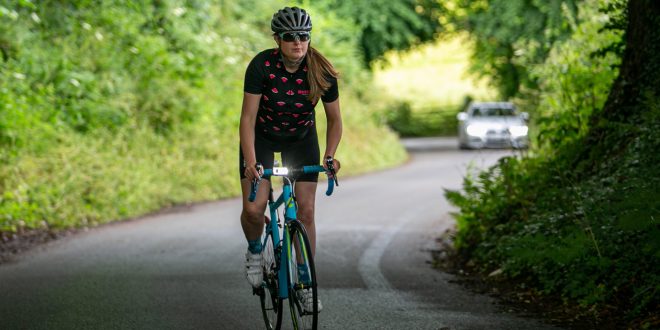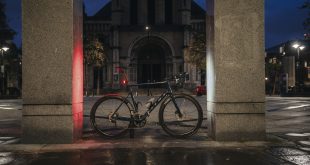BikeBiz sits down with See.Sense founders Irene and Philip McAleese
This piece first appeared in the January edition of BikeBiz magazine – get your free subscription here
I remember the first time I tried See.Sense bike lights back in 2018, when I needed to borrow a set of lights from a colleague to ride home from the office in the dark. The first thing that struck me was the intuitive way users could control the front and rear lights from the See.Sense app, but it wasn’t until I read more about the company that I began to see how innovative the product really was.
Founded in 2013 by Philip and Irene McAleese, See.Sense started as a bike light producer, offering unique connected lights with smart technology, but now into its 10th year, the Northern Ireland-based brand has developed into something much more impactful, thanks to the use of data.
 The origins
The origins
The See.Sense product originated in the mind of Philip, who used his background as an electronic and software engineer, combined with a love of cycling, to develop a new, safety-focused style of bike light.
Originally designed as a powerful, daytime visible light with a long battery life and innovative safety technology, See.Sense lights use advanced sensor technology to monitor the rider’s environment up to 800 times per second.
Using edge processing and AI, the lights flash brighter and faster in riskier moments such as roundabouts, road junctions, filtering in traffic and approaching car headlights, improving safety, while optimising battery life.
The first See.Sense intelligent light launched on Kickstarter in 2013, but it was in 2016 when Philip and Irene launched their first connected bike light, Icon, that See.Sense entered its new phase. Icon featured a host of connected features for the rider, but more importantly it allowed See.Sense to gather and aggregate data insights from across its community of users.
“Our products are at the heart of what we do,” Irene explained. “It is where we came from and we are passionate about: delivering a great product experience for our customers. However, we have seen that data is now a high growth part of our business and has overtaken product sales.”
See.Sense uses anonymised, granular data on road surface condition, swerving and braking patterns, speed, and dwell time, among other metrics. This data offers a remarkable insight into not only cycling habits, but also into safety and efficiency of a rider’s environment. See.Sense is already working with cities around the world to make life better and safer for bike riders.
Connected future
The information can be harnessed to help cities make informed decisions on cycling policy and infrastructure, as Irene explained: “The use cases for our data include identification of safety hotspots, the design and maintenance of cycling infrastructure and behaviour change programmes.
We recently completed a project working in London with TfL for example, that has shown our data can help inform their understanding of collisions and understanding of risk. It’s a great thing for our customers, knowing that just by riding their bike with a connected See.Sense light, they are gathering insights that can really help cities transform for more cycling.”
See.Sense’s business model is now two-fold – a B2C offering for commuter and road cyclists, along with a B2B model working with authorities and bike, e-bike, e-cargo, and e-scooter fleet operators to monitor and gather data insights.
 The network of See.Sense users is now more than 100,000, and growing. But as the data aspect of the business has overtaken the product side, See.Sense is also working with cities to get its lights into as many hands as possible to help collect data.
The network of See.Sense users is now more than 100,000, and growing. But as the data aspect of the business has overtaken the product side, See.Sense is also working with cities to get its lights into as many hands as possible to help collect data.
For example in Dublin, cyclists have been offered a heavily subsidised Icon light (€20 compared with RRP €90), in exchange for taking part in a survey to help collect data on cyclists across the city.
Irene said: “See.Sense data fills an important gap for cities since there is very limited data when it comes to cycling. Where it does exist, it is either a basic ‘count’ of cyclists or is crowdsourced GPS data.
“Because our devices gather such granular sensor data on swerving, braking and even the road surface conditions, we offer new insights into the cycling experience that go beyond what is typically available. This is why our data can be used for improved understanding of safety as well as the design and maintenance of cycling infrastructure.
“We’re working with partners such as RoSPA [Royal Society for the Prevention of Accidents], TfL [Transport for London], and the Transport Accident Commission in Victoria to achieve real impact in cities.”
Having utilised data to revolutionise their own business model, how do Philip and Irene see data impacting the wider cycling industry?
“A connected cycling experience, and that data that makes that possible, is a big differentiator for See.Sense,” said Irene. “It enables an improved experience for our customers that goes beyond being ‘just a bike light’, and means we can offer additional connected features such as crash and theft alerts, ride stats and the ability to report potholes or other issues.
“This means people who buy our lights form part of our community, and we build an ongoing relationship with them that goes beyond the initial product sale. The aggregated data insights they share with us are accessible by cities, who can use it to improve conditions for all cyclists which is something we are doing more and more of.
“We are a founding member of Cycling Industries Europe and a very active member of the Connected Cycling and ITS working group. Over the years we have seen more brands become interested in this space, and it is something we welcome.”
The product
While data now sits at the heart of See.Sense, it’s the product that has its success possible. See.Sense lights have picked up a host of awards and positive reviews, including The Independent’s IndyBest Best Buy Award, as well as Best Overall from ‘12 Best Bike Lights to keep you safe in 2021’. The ACE light was also rated 9/10 by Cycling Weekly.
 Late last year, See.Sense launched its latest model, the Icon3, which the brand says is already receiving “terrific” feedback from customers.
Late last year, See.Sense launched its latest model, the Icon3, which the brand says is already receiving “terrific” feedback from customers.
Again funded through a Kickstarter campaign, raising £95,000 from 1,200 backers, the Icon3 features increased brightness, USB-C charging, along with technology that senses moments of risk on the road, including roundabouts and junctions, along with ‘get me home’ and ‘brake mode’ options. Icon3 is 20% brighter than its predecessor.
350 lumen LEDs in the rear and 575 lumen LEDs in the front ensure you can be seen up to 3km away. A combination of CoB (chip on board) and two quality-focused LEDs give riders 270-degrees of side visibility, and shine brightly in both daylight and at night-time.
Through the app, riders can also access connected features such as crash and theft alerts, and personal ride stats, and improve the roads they cycle on by sharing anonymised insights to help cities and planners improve conditions for cycling. Icon3 is now available for purchase. The Icon3 Rear is £99.99 RRP, while the Icon3 Front and Rear Set is £179.99 RRP.
On the future of See.Sense, Irene said: “We have just released Icon3, and will aim to fully commercialise this product. We are looking for a UK distributor as well as more international distributors. We also have some new products in the wings, but it is too early to comment on those yet.
“Finally, we are working more and more with bike manufacturers and micromobility operators who want to embed our technology at the point of manufacture. Increasingly we see demand for bike manufacturers to want to improve the customer experience and having data is. key to that.
“In 2023 we will also launch our new employer offer, which allows employers to monitor the CO2 saved from their employees cycling, which can be used for sustainability reporting.”
 BikeBiz Bicycle and cycling retail news
BikeBiz Bicycle and cycling retail news




